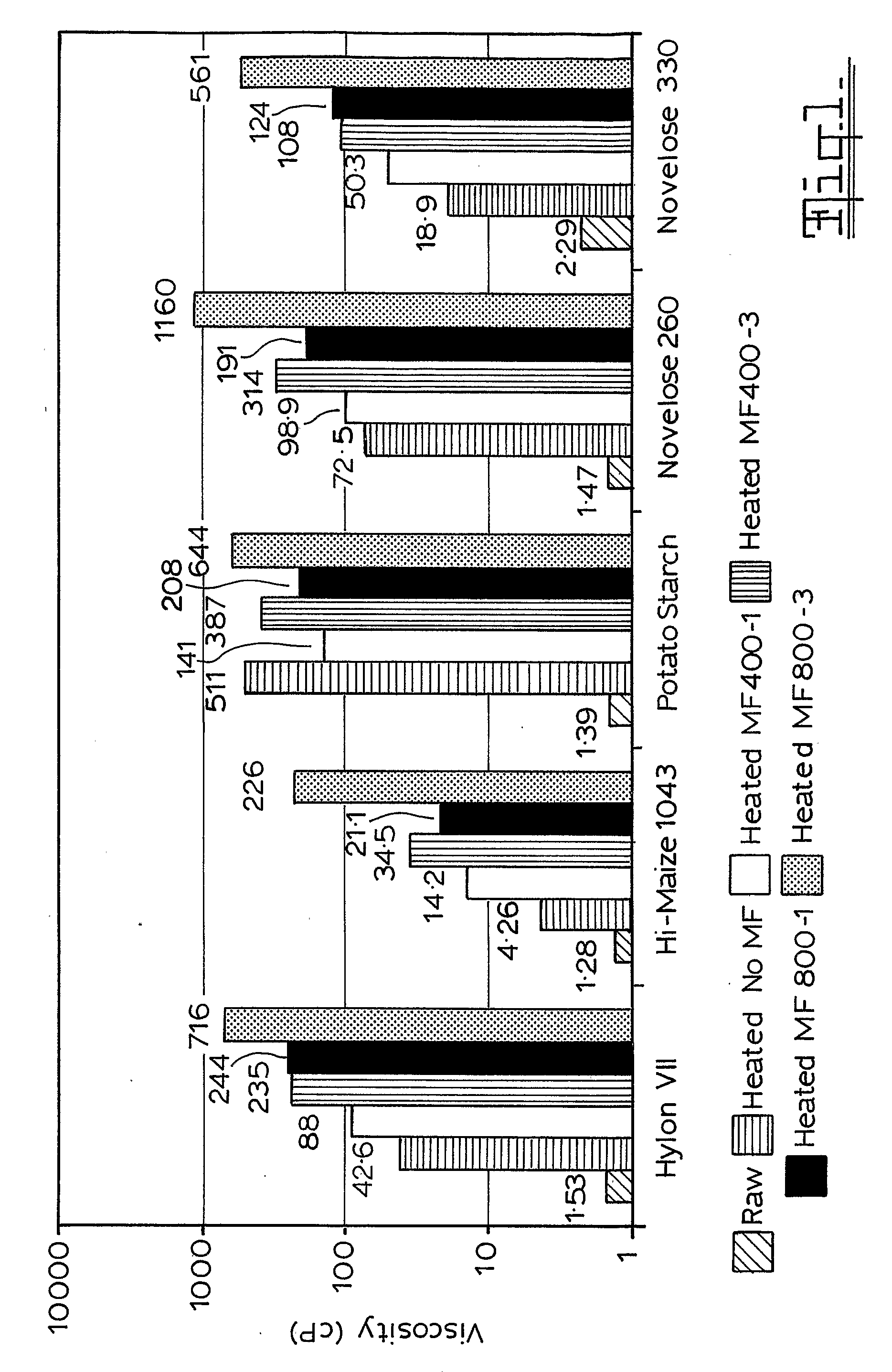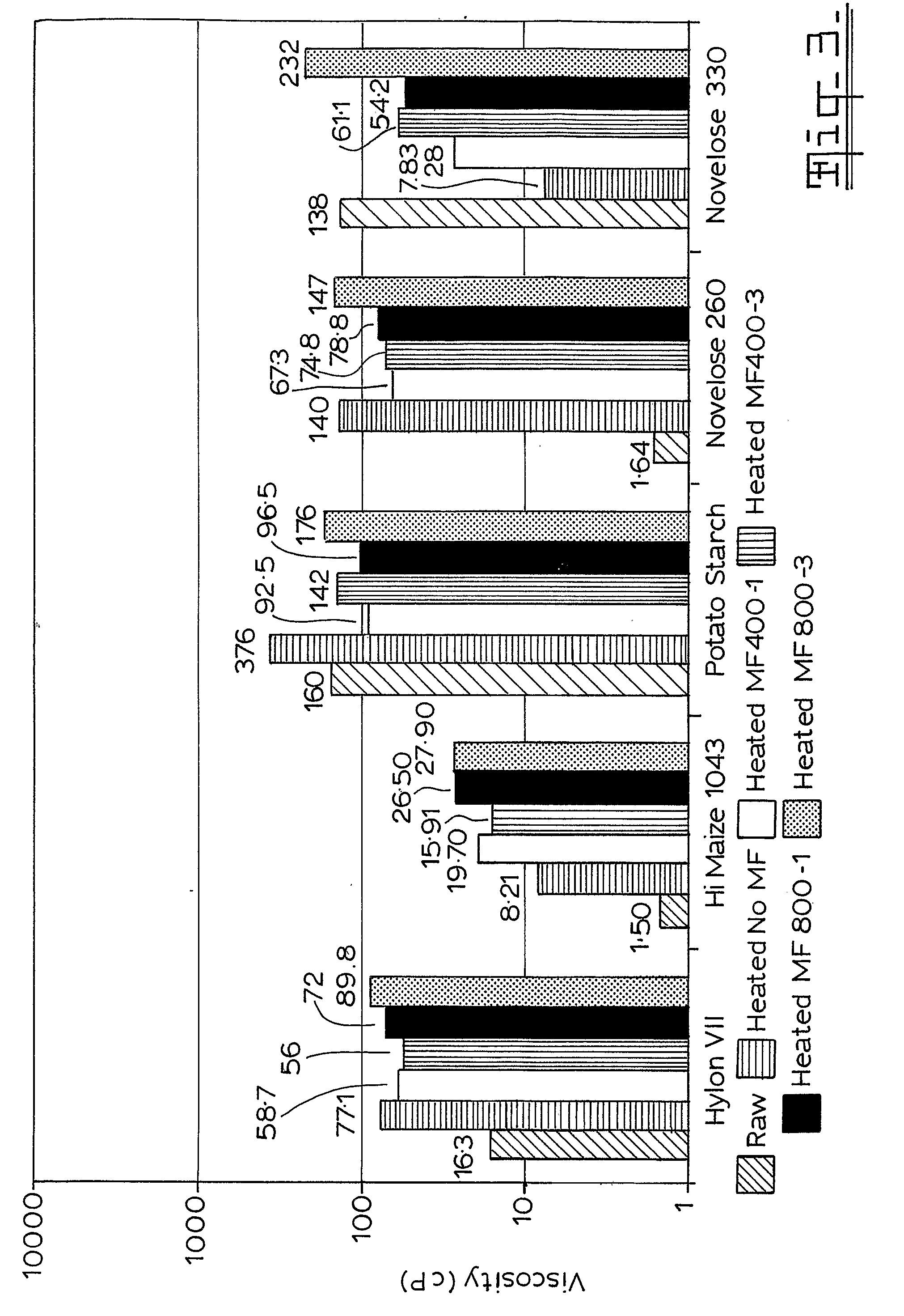Starch Treatment Process
- Summary
- Abstract
- Description
- Claims
- Application Information
AI Technical Summary
Benefits of technology
Problems solved by technology
Method used
Image
Examples
example 1
Characteristics of Microfluidised Resistant Starches
[0052]FIGS. 1 and 2 illustrate the effect of microfluidisation on the viscosity of wet starch properties.
[0053] As expected the viscosities of all raw resistant starches were low (1.3-2.3 cP). Heat treatment (121° C. / 60 min) increased viscosity of starch suspensions as expected because as the temperature is raised, there is swelling and gelatinsation of the starch granules with a concomitant increase in viscosity. The combined use of heat treatment and microfludisation markedly altered the viscosity of all processed resistant starch suspensions.
Processed Starch Suspension
[0054] The viscosities of these suspensions are given in FIGS. 1 and 2. In this case the resistant starches were tested after they have been pre-processed (ie heated at 121° C. / microfluidised) and are still in the liquid state (10% wt ingredient wt total suspension).
Viscosity at 50° C. after the Treatment Process
[0055] The viscosity at 50° C. of ...
example 2
Characteristics of Resistant starches treated by High Pressure Processing or Ultrasonics
[0064] Selected characteristics of the processed starches are given in Table 4.
TABLE 4Characteristics of Spray-dried Resistant starchestreated by High Pressure Processing or UltrasonicsHigh PressureRaw StarchUltrasonicatedProcessedCharacteristic(No treatment)StarchStarchResistant starch583535content (% w / wdry basis)Particle size6.8 (Mode)(μm)7.9 (Mean) 1.3 (Mean) 2.9 (Mean)
* Spray-dried at 185° C. inlet / 80° C. outlet
[0065] Approximately 60% of the original resistance is maintained after processing. The particle size data shows that there is a reduction in the size of the treated starches. The average molecular weight of the starch is also reduced (FIG. 9).
example 3
Characteristics of Microfluidised Non-Resistant Cereal Starches
[0066] Treatment of non-resistant starches modified the properties of non-resistant starches (Table 5, FIG. 10).
TABLE 5Characteristics of Microfluidised and Spray-DriedNon-Resistant cereal starchesResistantstarchParticleParticlecontentsizesize(g / 100 g(Mode)(Mean)StarchTreatmentdry basis)(μm)(μm)Corn starchNone0.911.08.6Heated MF6.31.0800-1Waxy maizeNone0.412.17.9Heated MF0.51.5800-1Wheat starchNone0.33.85.6Heated MF9.61.0800-1
* Spray-dried at 185° C. inlet / 80° C. outlet
[0067] The resistant starch content is increased after treatment and this was accompanied by a decease in the particle size of the particles. FIG. 10 indicates that the treatment caused a scission of bonds within the wheat starch molecule.
Performance of Modified Starch Ingredient in Products
[0068] To demonstrate the improved performance of the modified resistant starch ingredient, a number of product examples were formulated with the new ingredient ...
PUM
| Property | Measurement | Unit |
|---|---|---|
| Temperature | aaaaa | aaaaa |
| Temperature | aaaaa | aaaaa |
| Percent by mass | aaaaa | aaaaa |
Abstract
Description
Claims
Application Information
 Login to View More
Login to View More - R&D
- Intellectual Property
- Life Sciences
- Materials
- Tech Scout
- Unparalleled Data Quality
- Higher Quality Content
- 60% Fewer Hallucinations
Browse by: Latest US Patents, China's latest patents, Technical Efficacy Thesaurus, Application Domain, Technology Topic, Popular Technical Reports.
© 2025 PatSnap. All rights reserved.Legal|Privacy policy|Modern Slavery Act Transparency Statement|Sitemap|About US| Contact US: help@patsnap.com



